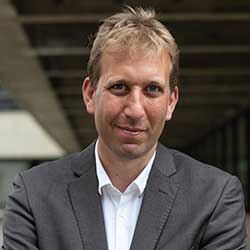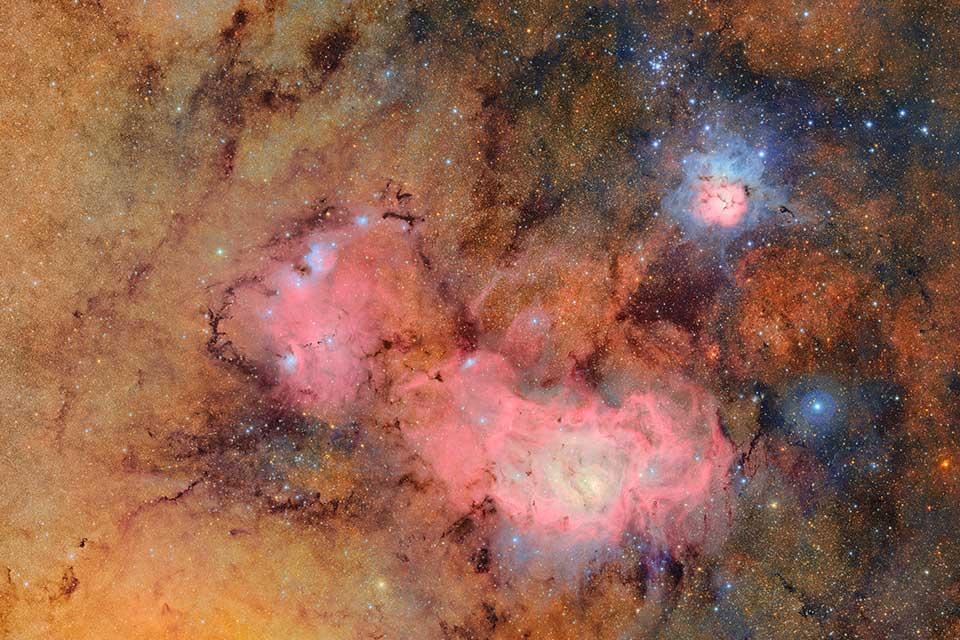The first images from the extraordinary NSF-DOE Vera C Rubin Observatory have been shared publicly today. Through its 10-year Legacy Survey of Space and Time (LSST) project, the ground-based telescope in Chile will bring the cosmos alive like never before: by repeatedly scanning the sky every three days for a decade, the Rubin Observatory will create an ultra-wide, ultra-high-definition timelapse record – effectively, a ‘movie of the sky’.
Rubin is the first of its kind. Its mirror design, camera size and sensitivity, telescope speed and computing infrastructure are each in an entirely new category. The petabytes of data that it produces should provide insight into four key science areas: Milky Way structure and formation; Solar System census; dark matter and dark energy; and the changing sky.
Oxford plays a key role in the LSST: UK consortium that comprises some 36 partners. Researchers across the Department of Physics are involved in different aspects of the ambitious project from contributing to the incredible 3.2 billion pixel camera to preparing for the vast amounts of data and their analysis and interpretation in the coming years…
Rubin/LSST's discovery potential is so large it brings together the scientific interests of several groups across Oxford’s Department of Physics including the sub-departments of Astrophysics (including Breakthrough Listen, Hintze and Beecroft Centres), Particle Physics and AOPP, and beyond including collaborators in AI/machine learning in the departments of Computer Science and Engineering.
Ten years in the making
 Dr Aprajita Verma reflects on Oxford’s journey to get to this significant milestone:
Dr Aprajita Verma reflects on Oxford’s journey to get to this significant milestone:
'Oxford has long history with the Rubin Observatory and the LSST. Our initial involvement was spearheaded by two individuals in particular: Roger Davies, now Emeritus Professor, first established us as an independent institutional partner of the then LSST Corporation (now the LSST Discovery Alliance). This was through the Hintze Centre for Astrophysical Surveys, now led by Professor Stephen Smartt FRS MRIA. In parallel, Professor Ian Shipsey FRS who sadly passed away suddenly last year, joined the Department of Physics as the Henry Moseley Centenary Professor of Experimental Physics in 2013, bringing with him a strong connection to Rubin. He was part of the group who pioneered the involvement of the US Department of Energy in the project and went on to play a key role in the development of LSST’s 3-Gigapixel CCD camera building on his extensive expertise with silicon detectors in the particle physics setting.
'This early involvement has meant that Oxford has helped to prepare for science with the facility. We have been fortunate enough to take on different leadership roles within Rubin’s eight science collaborations and beyond. I was the first non-US Science Collaboration lead for the Strong Lensing Science Collaboration 2017-2020 while Professor David Alonso, Dr Carlos Garcia-Garcia, Professor Maria Vincenzi and Professor Matt Jarvis, among others, have held key leadership positions in LSST:UK and Rubin’s Dark Energy and Galaxies Science Collaborations. Professor Smartt was a member of the overarching Rubin Science Advisory Committee and is a current member of the Survey Cadence Optimisation Committee that is crucially responsible for defining Rubin’s observation strategy to address multiple science goals. I am now the lead of the In-Kind Program for Rubin and member of the Rubin Operations Executive. The In-Kind Program is how Oxford and LSST:UK contribute to the project in return for access to the Rubin/LSST survey data; it spans contributions from more than 40 individual programs from 30 countries.
'We have championed the project for more than a decade and in July 2016, the Department of Physics hosted the Dark Energy Science Collaboration Meeting. This brought together colleagues from around the world reflecting our commitment to the project and we have subsequently hosted a number of Rubin-related science meeting including Galaxies, Strong Lensing and Transient and Lasair workshops. These have all been opportunities to bring together researchers from across the globe to share expertise and to ensure a truly groundbreaking project. This afternoon, we are hosting two First Look events: one for our students and staff in the Department of Physics and the other for the public.
'It is momentous that after more than a decade of involvement, we stand on the threshold of unlocking the potential of LSST; I am incredibly excited for the science and discovery that lie ahead.'
A camera like no other
 Particle physicist Professor Jeff Tseng worked alongside colleagues in Oxford and at SLAC National Accelerator Laboratory in California, on the world’s largest digital camera:
Particle physicist Professor Jeff Tseng worked alongside colleagues in Oxford and at SLAC National Accelerator Laboratory in California, on the world’s largest digital camera:
'LSST isn’t just about astrophysics! As particle physicists, our group has had a long and close involvement with Rubin, which complements experiments we conduct at high-energy colliders and neutrino and dark matter observatories. The late Ian Shipsey was one of the project's leads in both the US and UK, and he and Dr Dan Weatherill, with the Oxford Physics Microstructure Detector (OPMD) Laboratory, were among those involved in the detailed characterisation of LSST's camera sensors. Dr Weatherill was also deeply involved in the calibration systems and control software, in Oxford as well as on the summit in Chile while participating in commissioning efforts.
'Along with Dr Farrukh Azfar, I have worked with the SLAC camera software team on camera control, visualisation and monitoring software, and interfaces with data management. It is incredible to see the first look images from the world’s largest camera shared with everyone. Watching this remarkable camera operate and deliver astronomical images of such content and beauty is what we have been working towards with the incredible LSSTCam team. We eagerly await what’s to come next!'
Bigger and better
 Professor Stephen Smartt FRS MRIA was the Project Scientist for LSST:UK up until last year and he looks at what Rubin means to science:
Professor Stephen Smartt FRS MRIA was the Project Scientist for LSST:UK up until last year and he looks at what Rubin means to science:
'Rubin’s first look marks a step change in whole-sky surveys. We have already been surveying the whole sky for a number of years now, particularly with two projects: the Zwicky Transient Facility in California and the NASA funded Asteroid-Terrestrial Last Alert system (ATLAS) that has five units covering both the northern and southern hemispheres. At Oxford, we lead the ATLAS data processing and the UK project for scientific filtering and selection of transients. These two projects together allow us to survey the whole visible sky every night. These are however relatively small telescopes and the huge increase in sensitivity that Rubin will deliver is quite incredible.
'Rubin is a fast survey machine: with its enormous camera it can cover the whole southern hemisphere in a single night with a sensitivity 100 times better than the currently running surveys. We are looking forward to what this sensitivity leap will provide. We will compile the largest ever sample of supernovae for cosmology, search for distant planetary bodies in the solar system and uncover the origin of gravitational waves. I am particularly interested in what types of stellar explosions and deaths are currently undiscovered because they lie below the sensitivity of our current instruments.
'The data processing is a challenge and so we built Lasair, the UK broker that will sift through the 10 million sources that Rubin will find every night. It will extract the scientific potential from the stream by matching to all known galaxies and stars, classifying them, and immediately prioritising those for follow-up – in essence, it is a platform for scientists to make science. The opportunities are immense and we are incredibly excited to see what we will discover with Rubin.'
Rubin for everyone
 Professor Chris Lintott, presenter of the BBC’s The Sky at Night and founder of citizen science platform, Zooniverse explains how Rubin isn’t just for physicists.
Professor Chris Lintott, presenter of the BBC’s The Sky at Night and founder of citizen science platform, Zooniverse explains how Rubin isn’t just for physicists.
'I was attracted to work on the Rubin project by the promise of providing data for everybody - and that includes the public. In fact, we are going to need help to make the most of the overwhelming flood of data that is heading our way as the survey gets started. Drawing on our long experience of citizen science via the Zooniverse.org platform, which has helped more than two million people take part in science, classifying galaxies and discovering planets, we have been working with the Rubin Observatory to make it easy for astronomers to launch citizen science projects. In the next few months, anyone will have the chance to sort through Rubin images and help us understand the Universe, with no training required. Soon, the incredibly rich dataset will transform our understanding of the variable sky, capturing things that move, vary or explode – and we will need your help there too.
'Personally, I am most excited by the potential for discovery with Rubin, and we are planning to combine citizen science with advanced machine learning to find the most interesting unusual things in the data. Whenever we as a species have looked at the sky in a new way, we have been surprised – and I expect Rubin's view of the sky to be no exception.
'For the last 16 years, I have ended almost every talk I have given by speaking about the wonders we will find in Rubin data. I can't believe it is finally happening - and that ten years of discovery starts today.
'You can sign up now at zooniverse.org/rubin to be among the first to take part in our projects when they launch.'
About Rubin
- The observatory’s 3200-megapixel camera is the world’s largest digital camera. It’s the size of a car and weighs around 2,800kg.
- Each night the observatory will produce approximately 20 terabytes of data – that’s more data than three years of streaming video, or 50 years of streaming music.
- During its 10-year survey, Rubin will catalogue an estimated 17 billion stars, 20 billion galaxies, and millions of transients – more objects than there are living people on earth.
- Over a decade, Rubin data processing will generate around 500 petabytes, which is equivalent to the total amount of content written in every language throughout human history.
- The Rubin Observatory is located in Chile, on a mountain called Cerro Pachón. The observatory sits 2,647 metres above sea level.

